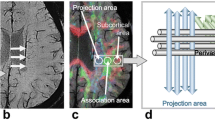Summary
Using immunocytochemistry (ICC), the number of immunoreaction products (IRPs) visualized for the peptide substance P (SP) appears reduced within the human spinal cord (also substantia nigra) taken at autopsy from cases diagnosed with Huntington's disease (HD) compared with the non-HD cases (Vacca 1983). The reductions of SR-IRPs become apparent in the HD specimens when primary anti-SP serum is applied to the tissue sections at “supra-optimal” dilutions; that is, dilutions greater than the “optimal” dilutions which visualize maximal numbers of SP-IRPs and concomitantly give maximal staining intensity. Curiously, the application of “optimal” dilutions to the HD and non-HD specimens visualizes equivalent numbers of SP-IRPs; therefore, the qualitative and quantitative differences between the specimens become masked. Applying “supra-optimal” dilutions of the anti-SP serum unmasks the difference, and also reveals different end-points for the immunostain deposited in each type of specimen. In both the HD and non-HD specimens, two sizes of SP-IRPs could be identified, large (3 μm) and small (0.7 μm). Presumably they mark two different categories of axons defined by caliber (e.g.; C-type and A γ), or origin (e.g., sensory intrinsic, or supraspinal). Alternatively the large SP-IRPs label tangentially-cut or large axons and nerve terminals. In the present report, counts of the large and small SP-IRPs visualized in the HD and the non-HD specimens have been plotted against the serial dilutions (optimal, supra-optimal and endpoint) of the primary anti-SP serum used for ICC. The graphs which result, describe a “titration curve” characteristic for the large SP-IRPs in each specimen. Applying supra-optimal dilutions of the primary antibody, causes the numbers of large and small SP-IRPs to decrease differentially. The numerical decrease probably largely reflects the concentration of immunoreactive antigen in different anatomic or metabolic tissue compartments. Alternatively, or perhaps to a lesser degree, the small and large SP-IRPs represent cross-reacting components which have different staining end-points, and may have biological significance in HD. Criteria are given for the proper use of ICC, and have significance regarding the use of commercial kits especially for pathological diagnosis.
Similar content being viewed by others
References
Chang MM, Leeman SE (1970) Isolation of a sialogogic peptide from bovine hypothalamic tissue and its characterization as substance P. J Biol Chem 245:4784–4790
Von Euler US, Gaddum JH (1931) An unidentified depressor substance in certain tissue extracts. J Physiol 72:74–87
Forno LS, Jose C, (1973) Huntington's chorea: A pathological study. Adv Neurol 1:453–473
Hökfelt T, Johansson O, Kellereth JO, Ljungdahl, A, Nilsson G, Nygards A, Pernow, B (1977) Immunohistochemical distribution of substance P. In: Von Euler US, Pernow B (eds) Substance P. Raven Press, New York, pp 117–145 (Nobel Symp 37)
Kakudo K, Paull WK, Vacca LL (1981) Immunocytochemical study of substance P containing nerve terminals in rat spinal cord: Technical considerations. Histochemistry 71:17–32
Moriarty GC, Moriarty CM, Sternberger LA (1973) Ultrastructural immunocytochemistry with unlabeled antibodies and the peroxidase anti-peroxidase complex: A technique more sensitive than radioimmunoassay. J Histochem Cytochem 21:825–833
Petrali JP, Hinton DM, Moriarty GC, Sternberger, LA (1974) The unlabeled antibody enzyme method of immunocytochemistry. Quantitative comparison of sensitivities with and without peroxidase-antiperoxidase complex (PAP). J histochem Cytochem 22:782–795
Petrusz P (1983) Essential requirements for the validity of immunohistochemistry staining procedures. J Histochem Cytochem 31:177–179
Pickel VM, Reis, DJ, Leeman SE (1977) Ultrastructural localization of substance P in neurons of rat spinal cord. Brain Res 122:534–540
Powell D, Leeman S, Treagear GW, Niall, D, Potts JT Jr (1973) Radioimmunoassay for substance P. Nature (New Biol) 241:252–254
Schultzberg M, Dalsgaard C-J, Sharkey K, Williams RG, Dockray GJ, Hökfelt T (1983) Sustance P and bombesin-like peptides in the peripheral nervous system. In: Skrabanek P, Powell D (eds) Substance P-Dublin 1983. Boole Press, Dublin, pp 249–250
Sternberger, LA (1979) Immunocytochemistry, 2nd edit. John Wiley and Sons, New York
Sternberger LA, Hardy PH Jr, Cuculis JJ, Meyer HG (1970) The unlabeled antibody-enzyme method of immunohistochemistry. Preparation and properties of soluble antigen-antibody complex (horseradish peroxidase-antiperoxidase) and its use in identification of spirochetes. J Histochem Cytochem 18:315–328
Takakashi T, Otsuka M (1975) Regional distribution of substance P in the spinal cord and nerve roots of the cat and the effect of dorsal root section. Brain Res 87:1–11
Tessler A, Glazer E, Artymyshyn R, Murray M, Goldfinger ME (1980) Recovery of substance P in the cat spinal cord after unilateral lumbosacral deafferentation. Brain Res 191:459–470
Vacca LL (1982) Double bridge techniques of immunocytochemistry. In: Bullock G, Petrusz P (eds) Techniques in immunocytochemistry. Academic Press, London, vol 1, pp 155–182
Vacca LL (1983) Substance P appears reduced in Huntington's disease: Immunocytochemical findings in substantia nigra and substantia gelationsa. J Submicrosc Cytol 15:569–582
Vacca LL, Rosario S, Zimmerman EA, Tomachefsky P, Ng P-Y, Hsu KG (1975) Application of immunoperoxidase techniques to localize horseradish peroxidase tracer in the central nervous system. J. Histochem Cytochem 23:208–215
Vacca LL, Hewett D, Woodson G (1978) A comparison of methods using diaminobenzidine (DAB) to localize peroxidases in erythrocytes, neutrophils, and peroxidase. Stain Technol 53:331–336
Vacca LL, Abrahams SJ, Naftchi NE (1980a) A modified peroxidase antiperoxidase procedure for improved localization of tissue antigens: localization of substance P in rat spinal cord. J Histochem Cytochem 28:297–307
Vacca LL, Abrahams SJ, Naftchi NE (1980b) Effects of morphine on substance P containing neurons in spinal pain pathways: a preliminary study. Brain Res 182:229–236
Vacca LL, Hobbs J, Abrahams SJ, Naftchi NE (1982) Ultrastructural localization of substance P immunoreactivity in the ventral horn of the rat spinal cord. Histochemistry 76:33–49
Zehr DR (1978) Use of hydrogen peroxidase-egg albumen to eliminate nonspecific staining in immunoperoxidase techniques. J Histochem Cytochem 26:415–416
Author information
Authors and Affiliations
Rights and permissions
About this article
Cite this article
Vacca-Galloway, L.L. Differential immunostaining for substance P in Huntington's Diseased and normal spinal cord: significance of serial (optimal, supra-optimal and end-point) dilutions of primary anti-serum in comparing biological specimens. Histochemistry 83, 561–569 (1985). https://doi.org/10.1007/BF00492461
Received:
Accepted:
Issue Date:
DOI: https://doi.org/10.1007/BF00492461




